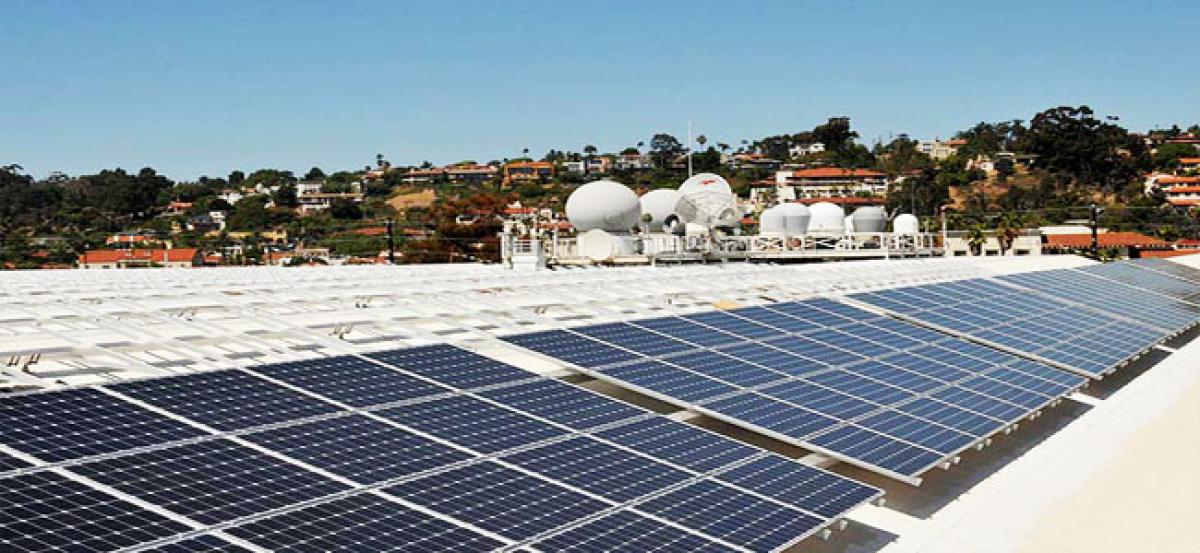Live
- Air quality in Kolkata dips to ‘very unhealthy’ category
- Air pollution may raise risk of lung cancer, asthma in children, say experts
- Yashoda Medicity organizes “Crown of Courage” ceremony to honor Cancer Survivors
- NCB, Gujarat ATS seize 500 Kg of drugs in joint op in Porbandar
- Senior citizens of all states to get 25pc bus fare concession in Andhra
- India’s total exports likely to surpass $800 billion in coming months: Industry
- Almost half of injury-related hospitalisations in Australia caused by falls: Report
- Tribals ignored by past regimes, remain top priority in NDA govt: PM Modi in Jamui
- South Korea: Opposition leader sentenced to suspended prison term for violating election law
- Ajinkya Rahane to lead Mumbai in Syed Mushtaq Ali Trophy
Just In

Statements from officials insinuating that Indians want to use their rooftops for alternative purposes such as drying clothes, sleeping and hosting parties are extremely misleading. RTPV systems can easily be designed with raised mounting structures, at low incremental costs, to keep enough free space and provide a cooling effect below.
Recent newspaper articles have highlighted the rooftop photovoltaic (RTPV) sector's sluggish growth in India. The articles claim that based on the present outlook, the 40 GW target for 2021-22 will not be achieved.
Greenpeace India's report shows that RTPV uptake in major cities such as Delhi, Mumbai, Bengaluru, Hyderabad and Chennai has been abysmal. While the large-scale ground mounted solar parks have gathered critical mass in India with tariffs as low as Rs 2.44/kWh, RTPV is lagging behind significantly, comprising only about 1.46 GW of today's 12.5 GW installed solar capacity.
Statements from officials insinuating that Indians want to use their rooftops for alternative purposes such as drying clothes, sleeping and hosting parties are extremely misleading. RTPV systems can easily be designed with raised mounting structures, at low incremental costs, to keep enough free space and provide a cooling effect below.
A deeper look into the problem reveals the major barriers hindering growth of RTPV in India.A typical kW level system costs Rs 50,000-65,000/kWp which is 1.25-1.75 times more than ground-mounted behemoths. For a lucrative business case for prospective consumers, with a healthy internal rate of return (IRR>13 per cent) and payback period (<7 years), the net-metering (NM)/ gross-metering (GM) rate should be in the range of Rs 5.5-6.5/kWh.
However, most distribution companies (Discoms) in India are suffering financially and cannot afford to pay such rates. Keeping this conundrum in mind, State Electricity Regulatory Commissions (SERCs) fix NM/GM rates at Average Pooled Power Purchase Cost (APPC) of the Discoms, which are rarely over Rs 4/kWh. Karnataka has more attractive rates, but delays in payments from Discoms have led to banks becoming wary of lending to this sector.
Delhi offers a Generation Based Incentive (GBI) of Rs 2/kWh above APPC for the first three years, however that barely pushes IRR to 11 per cent. The central government offers a capital subsidy of 30 per cent but consumers' experiences show that the hassles to avail this far outweigh the prize. With unviable business cases and lack of access to finance, it is no wonder that RTPV faces stagnation in India.
To provide a much-needed thrust to this sector, it is imperative to bring down costs to a level where Discoms are comfortable (near the APPC). For large solar parks, a host of incentives, like readily available land and evacuation infrastructure, and risk-free Power Purchase Agreements (PPAs) with Reserve Bank of India backing, have helped developers reduce costs drastically.
Unfortunately, the same efforts have not been extended to RTPV, apart from Solar Energy Corporation of India (SECI) recently tendering out 1.5 GW across all Indian states on government buildings.
A more innovative approach needs to be taken by the central and state governments, in collaboration with Discoms, to promote RTPV. A thorough potential assessment exercise needs to be undertaken for all major cities and towns to identify suitable rooftops, after taking shading aspects into consideration.
Unlike ground-mounted systems, an RTPV system's economics is heavily impacted by shadows of neighbouring buildings, poles, trees and obstructions. Thus, 3D imaging and GIS with aerial photography need to be employed to accurately calculate the potential on each rooftop along with the business case based on consumption data provided by the Discoms.
By Saptaik Ghosh

© 2024 Hyderabad Media House Limited/The Hans India. All rights reserved. Powered by hocalwire.com







